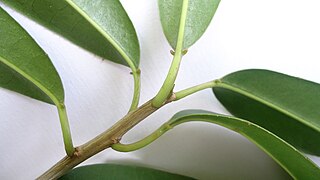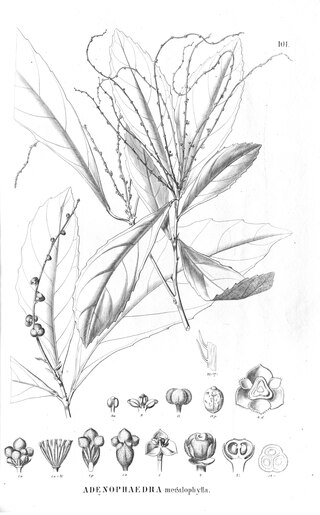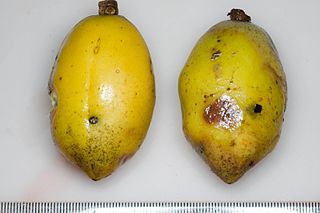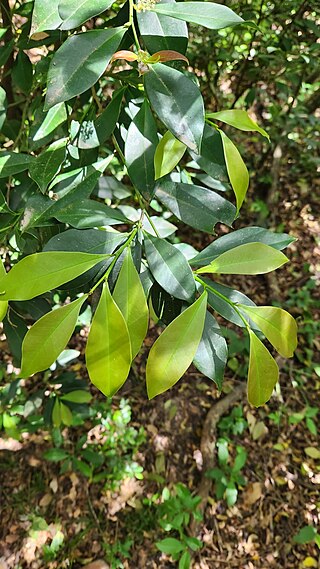
Sapium is a genus of flowering plants in the family Euphorbiaceae. It is widespread across most of Latin America and the West Indies. Many Old World species were formerly included in the genus, but recent authors have redistributed all the Old World species into other genera.
Mareya is a plant genus of the family Euphorbiaceae, first described as a genus in 1860. It is native to tropical western and central Africa.
Mareyopsis is a plant genus of the family Euphorbiaceae first described as a genus in 1919. It is native to western and central Africa.
- Mareyopsis longifolia(Pax) Pax & K.Hoffm. - Nigeria, Cameroon, Gabon, Equatorial Guinea, Congo-Brazzaville, Zaire
- Mareyopsis oligogynaBreteler - Gabon

Aparisthmium is a plant genus of the family Euphorbiaceae first described as a genus in 1840. It contains only one known species, Aparisthmium cordatum, native to South America and Costa Rica.

Conceveiba is a plant genus of the family Euphorbiaceae, first described as a genus in 1775. It is native to South America and Central America.
- Conceveiba guianensisAubl. - Brazil, Peru, Bolivia, Ecuador, Colombia, Venezuela, 3 Guianas
- Conceveiba hostmaniiBenth. - Guyana, Suriname, Amazonas State in Brazil
- Conceveiba krukoffiiSteyerm. - Venezuela, French Guiana, NW Brazil
- Conceveiba latifoliaBenth. - Colombia, Venezuela, Peru, Amazonas State in Brazil
- Conceveiba martianaBaill. - Venezuela, French Guiana, NW Brazil, Colombia, Ecuador, Peru, Bolivia
- Conceveiba maynasensisSecco - Loreto in Peru
- Conceveiba parvifoliaMcPherson - Panama, NW Colombia
- Conceveiba pleiostemonaDonn.Sm. - Costa Rica, Nicaragua, Colombia, Venezuela
- Conceveiba praealta(Croizat) Punt ex J.Murillo - NW Brazil
- Conceveiba ptariana(Steyerm.) Jabl. - S Venezuela
- Conceveiba rhytidocarpaMüll.Arg. - Colombia, Ecuador, Peru
- Conceveiba santanderensisJ.Murillo - NW Colombia
- Conceveiba terminalis(Baill.) Müll.Arg. - Venezuela, Guyana, Suriname, NW Brazil, Colombia, Peru
- Conceveiba tristigmataJ.Murillo - Colombia, Venezuela, NW Brazil

Adenophaedra is a plant genus of the family Euphorbiaceae first described as a genus in 1874. It is native to tropical regions of South America and Central America.
- Adenophaedra cearensis Secco - Ceará
- Adenophaedra grandifolia (Klotzsch) Müll.Arg. - Costa Rica, Panama, Colombia, Venezuela, Guyana, French Guiana, Ecuador, Peru, NW Brazil
- Adenophaedra megaphylla (Mull.Arg.) Mull.Arg. - Colombia, Ecuador, Peru, Suriname, E Brazil
Bernardia is a plant genus of the family Euphorbiaceae first described for modern science as a genus in 1754. It is native to North and South America, as well as the West Indies.

Caperonia is a genus of plants of the family Euphorbiaceae first described as a genus in 1825. The genus is native to tropical and subtropical America and Africa.
Astrococcus is a genus of plant of the family Euphorbiaceae first described as a genus in 1854. It contains only one known species, Astrococcus cornutus, native to neighboring states of identical names, Amazonas State in southern Venezuela and Amazonas State in northwestern Brazil.

Glycydendron is a genus of plants, under the family Euphorbiaceae first described as a genus in 1922. It is native to South America.
- Glycydendron amazonicumDucke - French Guinea, Suriname, Guyana, Ecuador, Peru, Bolivia, northwestern Brazil, possibly Colombia
- Glycydendron espiritosantenseKuhlm, - State of Espírito Santo in Brazil

Sandwithia is a plant genus of the family Euphorbiaceae first described in 1932. It is native to northern South America. It is dioecious.
- Sandwithia guyanensisLanj. - French Guiana, Guyana, Venezuela, N Brazil
- Sandwithia heterocalyxSecco - SE Colombia, S Venezuela, N Brazil
Dodecastigma is a genus of plants under the family Euphorbiaceae first described as a genus in 1932. It is native to northern South America.
- Dodecastigma amazonicumDucke - Amazonas State in Brazil
- Dodecastigma integrifolium(Lanj.) Lanj. & Sandwith - French Guiana, Guyana, N Brazil
- Dodecastigma uleanum(Pax & K.Hoffm.) G.L.Webster - Amazonas, Amapá
Micrandra is a plant genus of the family Euphorbiaceae first described in 1854. It is native to South America.

Actinostemon is a plant genus of the family Euphorbiaceae first described as a genus in 1841. It is native to South America, Central America, and the West Indies.
Dendrothrix is a plant genus of the family Euphorbiaceae first described as a genus in 1996. It is native to southern Venezuela and northwestern Brazil.
- Dendrothrix multiglandulosaEsser - Amazonas State in Venezuela
- Dendrothrix wurdackiiEsser - Amazonas State in Brazil
- Dendrothrix yutajensis(Jabl.) Esser - Amazonas State in Brazil; Amazonas & Bolívar States in Venezuela

Maprounea is a plant genus of the family Euphorbiaceae first named as a genus in 1775. It is native to tropical Africa, Trinidad, and tropical Central and South America.
- Maprounea africana - W + C + S Africa, from Benin to Zimbabwe
- Maprounea amazonica - Colombia, Venezuela, N Brazil
- Maprounea brasiliensis - Brazil, Paraguay, Bolivia
- Maprounea guianensis - Trinidad, Panama, Colombia, Venezuela, French Guiana, Suriname, Guyana, Brazil, Peru, Ecuador, Bolivia, Paraguay
- Maprounea membranacea - Nigeria, Cameroon, Gabon, Equatorial Guinea, Cabinda, Central African Republic, Congo, Zaire
Rhodothyrsus is a plant genus of the family Euphorbiaceae, first described as a genus in 1999. It is native to South America.
- Rhodothyrsus hirsutusEsser - Colombia, NW Venezuela
- Rhodothyrsus macrophyllus(Ducke) Esser - Guyana, Suriname, Colombia, Peru, N Brazil

Spirostachys is a plant genus of the family Euphorbiaceae first described as a genus in 1850. It is native to Africa. Zuloaga, F. O., O. Morrone, M. J. Belgrano, C. Marticorena & E. Marchesi. (eds.) 2008. Catálogo de las plantas vasculares del Cono Sur. Monographs in systematic botany from the Missouri Botanical Garden 107(1–3): i–xcvi, 1–3348.
Discocarpus is a genus of the plant family Phyllanthaceae first described as a genus in 1841. It is native to northern South America. It is dioecious, with male and female flowers on separate plants.
- Discocarpus essequeboensisKlotzsch - Brazil, Venezuela (Amazonas), Guyana, Suriname, French Guiana
- Discocarpus gentryiS.M.Hayden - S Venezuela (Amazonas), Peru (Loreto), N Brazil
- Discocarpus pedicellatusFiaschi & Cordeiro - State of Bahia in Brazil
- Discocarpus spruceanusMüll.Arg. - Venezuela (Amazonas), Brazil, Suriname (Sipaliwini), Bolivia

Bia is a genus of plant of the family Euphorbiaceae first described as a genus in 1841. The entire genus is native to South America.
- Bia alienataDidr. - Brazil, Bolivia, Paraguay, N Argentina
- Bia capivarensisMedeiros & Alves - Serra da Capivara
- Bia fallax(Müll.Arg.) G.L.Webster - Peru, Rondônia
- Bia fendleri(Müll.Arg.) G.L.Webster - Guyana, Venezuela, Amazonas State of Brazil
- Bia lessertianaBaill. - Fr Guiana, Suriname, Guyana, N Brazil
- Bia manueliiV.W. Steinm. & Ram.-Amezcua, 2013, Sierra de Coalcomán, Michoacán, Mexico










